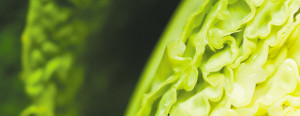“An idealist is one who, on noticing that a rose smells better than a cabbage, concludes that it will also make better soup.” H.L. Mencken
Before immigrating to the United States in the 1920’s, my parents had never heard of eating corned beef with cabbage. Once here, they quickly adopted the American St. Patrick’s Day tradition expected of all good Irishmen… and not-so-Irish-men.
Unfortunately the one-pot-wonder-recipe my mother found in a newspaper involved boiling the life out of everything until the beef was fork-tender (a good thing), the potatoes had reduced to a watery pulp (not such a good thing), and the only thing holding the cabbage together was its overpowering stench. No wonder people drink green beer.
That was then and this is now. It’s time to give cabbage its due respect. High in fiber and low in cost and calories (a mere 22 for 1 cup of uncooked chopped cabbage!), there is good reason why it has been savored all over the world since ancient times. Braised, steamed, stir-fried, stuffed, or raw for slaw, this cruciferous vegetable contains a goodly amount of vitamin C as well as some vitamin A.
Colcannon is a classic Irish dish that showcases the less scary side of cabbage. To make it, simply stir cooked cabbage into buttery, freshly mashed potatoes. When entertaining, however, I often introduce cabbage to an old standby potato recipe that can be made a day or two in advance. (The addition of cream cheese, though barely perceptible, acts as a stabilizer to keep the spuds creamy.) I happen to prefer the texture of potatoes whipped with an electric mixer, but feel free to go old-school and mash them by hand.
This may not be the best choice for weight watchers, but St. Patrick’s Day comes but once a year.
Make-Ahead Colcannon
10 medium russet or Yukon Gold potatoes (about 3 1/2 pounds total), skins on, scrubbed clean
6 tablespoons butter, plus extra for greasing the baking dish, at room temperature
1 small head of cabbage (about 1 pound), cored and thinly sliced or chopped (to make 3 to 4 cups)
1 (8 ounce) package cream cheese, at room temperature
1/2 cup heavy (whipping) cream, half-and-half, or whole milk
Salt and freshly ground pepper
Paprika and/or chopped fresh chives or parsley for garnish
1. In a large pot, boil the potatoes in salted water until tender when pierced with the tip of a sharp knife, 25 to 30 minutes. Drain in a colander. When cool enough to handle, peel if desired.
2. In the same pot, melt 2 tablespoons of the butter over medium heat. Add the cabbage and cook, stirring occasionally, until wilted, 3 to 5 minutes.
3. Using an electric mixer, mix together the cream cheese, cream, and another 2 tablespoons of the butter until blended. Gradually add the hot potatoes, beating after each addition until smooth and soft. Stir in the cabbage. Season to taste with salt and pepper.
4. Spoon the potato mixture into abuttered 2- to 2 1/2 quart baking dish or ovenproof casserole. Melt the remaining 2 tablespoonsof butter and drizzle over the top. (At this point, potatoes can be covered with plastic wrap and refrigerated for up to 2 days; return to room temperature before reheating. Or, if potatoes are made only 2 hours before serving, refrigeration is unnecessary; leave in a cool spot, covered, at room temperature.)
5. Preheat the oven to 350° F. Bake, uncovered, until heated through and lightly browned on top, about 30 minutes. (Alternatively, reheat in the microwave.) Just before serving, dust lightly with paprika and sprinkle chives over the top. Serves 8 to 10, though—since this reheats beautifully—you will probably want leftovers for the next day.
Variations:
–Use an equal amount of thinly sliced kale instead of cabbage.
–Or, for a make-ahead version of another Irish classic called Champ (one of my dad’s favorites), substitute 1 bunch of thinly sliced green onions (scallions) for the cabbage.
Cabbage Trivia
–Cabbage varieties include the commonplace pale green (often bordering on white), red, crinkly Savoy, the elongated Chinese Napa cabbage, and bokchoy.
–A member of the mustard family, cabbage has a long list of relatives that includes broccoli, cauliflower, Brussels sprouts, kale, kohlrabi, turnips, and rutabaga.
–The word cabbage is a derivation of the French word caboche, a common term for “head.”
–Just-picked cabbage does not deteriorate as quickly as many other vegetables, but does lose moisture when refrigerated. Many farmers’ market growers harvest their cabbage once or twice a week so it doesn’t remain too long in a cooler. Because of this, farmers’ market shoppers get a sweeter, crisper, juicier cabbage than they would find in a supermarket.
–Look for cabbages that are firm and feel heavy for their size.
–Store farm-fresh cabbage in an open plastic bag in the refrigerator for up to 10 days.
–Unadorned cabbage makes a great backdrop for other flavors. For variety when cooking, add bits of bacon, prosciutto, or pancetta; caraway or fennel seed; onion; garlic; or fresh herbs to enhance flavor. Dried fruit or freshly sliced apple are also nice additions; or simply toss cooked cabbage with freshly grated Parmesan cheese just before serving.
The Danville Certified Farmers’ Market, located at Railroad and Prospect, is open every Saturday, rain or shine, from 9 a.m. until 1 p.m. For specific crop information call the Pacific Coast Farmers’ Market Association at 1-800-949-FARM, or visit their web site at www.pcfma.com. This market is made possible through the generous support of the Town of Danville. Please show your appreciation by patronizing the many fine shops and restaurants located in downtown Danville. Buy fresh. Buy local. Live well!
Leave a Reply